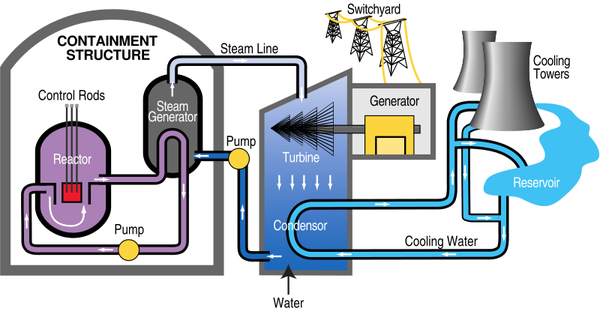Difference between revisions of "Nuclear Fuel"
(→Key Stage 4) |
|||
| Line 17: | Line 17: | ||
|[[File:NuclearPowerStationDiagram.png|center|600px]] | |[[File:NuclearPowerStationDiagram.png|center|600px]] | ||
|- | |- | ||
| − | | style="height:20px; width:200px; text-align:center;" |A [[diagram]] of a [[coal]] [[power station]]. | + | | style="height:20px; width:200px; text-align:center;" |A [[diagram]] of a [[coal]] [[Thermal Power Station|power station]]. |
|} | |} | ||
: 1. '''Nuclear Fuel''' undergoes a [[Nuclear Reaction|nuclear reaction]] in the [[Reactor Core|reactor core]]. | : 1. '''Nuclear Fuel''' undergoes a [[Nuclear Reaction|nuclear reaction]] in the [[Reactor Core|reactor core]]. | ||
| Line 29: | Line 29: | ||
*Can work continuously. | *Can work continuously. | ||
*Power supply can be varied depending on demand. | *Power supply can be varied depending on demand. | ||
| − | *Few power | + | *Few [[Thermal Power Station|power station]]s needed to supply a large number of houses. |
*High energy density (1kg of Uranium can provide the same energy as 10,000kg of coal). | *High energy density (1kg of Uranium can provide the same energy as 10,000kg of coal). | ||
Revision as of 08:20, 6 April 2019
Contents
Key Stage 3
Meaning
Nuclear Fuel is a radioactive material which can be used to generate electricty.
About Nuclear Fuel
- Nuclear Fuel has energy in its nuclear potential energy store which can be easily transferred into its thermal energy store.
- The most common nuclear fuels are Uranium-235 and Plutonium-239.
- Nuclear Fuel transfers energy to the thermal energy store during a nuclear reaction.
- Nuclear Fuel is very dangerous because it is radioactive which causes harm to living organisms.:
- When nuclear fuel is used the waste products are still radioactive so they must be buried deep underground where they cannot harm living organisms.
Power
- Nuclear Fuel can be used to provide power by generating electricity that can be sent to houses and industry.
| A diagram of a coal power station. |
- 1. Nuclear Fuel undergoes a nuclear reaction in the reactor core.
- 2. Water in the reactor core is heated and passed through a heat exchanger.
- 3. Water in the reactor core becomes contaminated with radioactive material so the heat exchanger heats up uncontaminated water.
- 3. The uncontaminated water turns to steam and passes down pipes to turn a turbine.
- 4. The turbine causes a generator to spin.
- 5. The generator makes an electrical current.
Advantages
- Can work continuously.
- Power supply can be varied depending on demand.
- Few power stations needed to supply a large number of houses.
- High energy density (1kg of Uranium can provide the same energy as 10,000kg of coal).
Disadvantages
- Cost of fuel.
- Difficult to safely dispose of nuclear waste.
- There is a small risk of meltdown.
